Fixes for 'File Is Too Large for Destination File System' on USB/External Hard Drive
"Yesterday, when I tried to copy some large files including Windows 10 ISO files, the backup images of my operating system, movies, personal video files, and other data to my 32 GB external hard drive, I received the error message saying "The file is too large for the destination file system." I don't know why it happened as there was enough free space on the disk. Can anyone help?"
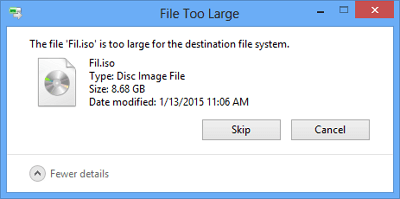
What's The Reason for The 'file is too large' Error?
When facing the "The file is too large for the destination file system" issue in Windows 10/8/7, you might get confused about why you would not be able to copy the file to your USB flash drive when there is sufficient free space.
The problem occurs because one of the files you want to transfer is larger than 4 GB and your USB flash drive is using the FAT32 file system, of which the maximum file size is 4GB. For a FAT16 USB flash drive, the maximum file size is 2GB. There is a built-in limitation in the FAT32 file system: Although the total size of the files you can store on a FAT32 drive could be up to 2TB, you cannot save an individual file that exceeds 4GB on it.
2 Efficient Solutions to Fix Your Problem
After figuring out the reason for "The file is too large for the destination file system" issue, you can fix it with ease, that is to convert the file system from FAT32/FAT16 to NTFS. Here we will introduce you to two easy solutions. We will show you how to use these two methods to fix the "The file is too large for the destination file system" error with simple steps.
Solution 1: Formatting FAT32 to NTFS with Windows built-in feature
Formatting is the easiest way for you to convert FAT32 to NTFS. But notice that it will erase all the existing data on the drive. So, it is recommended only when there are no files on your external hard drive or USB flash drive. If there are files existing on your storage device, you can back them up by manually copying or using free backup software in advance. Here's how to do it with Windows built-in format feature.
Step 1: Connect your USB flash drive to the computer.
Step 2: Right-click on the USB drive or external hard drive and click "Format".
Step 3: Change the type to NTFS.
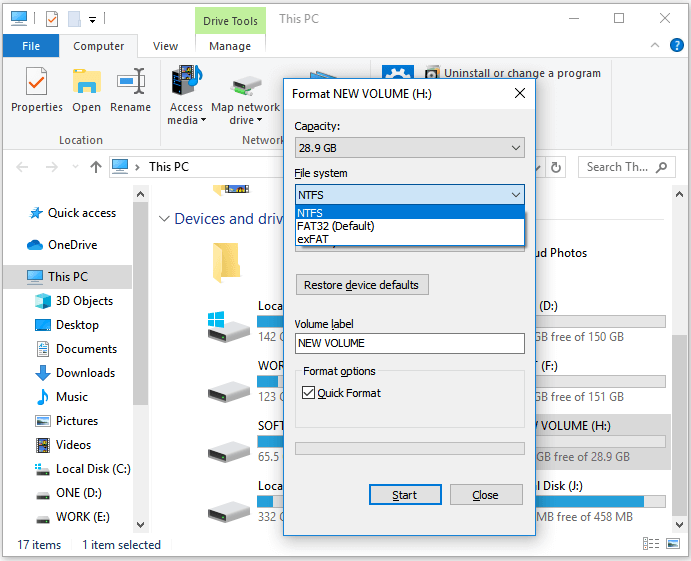
Done!! Now you have fixed the issue "The file is too large for the destination file system" and can successfully copy a file larger than 4GB to the external USB drive or hard drive.
Solution 2: Converting FAT32 to NTFS without data loss
If you want to finish this task in a more convenient way, here's a better solution. Converting FAT32 to NTFS without data loss using the partition tool - Qiling Partition Master. This popular third-party partition software is an optimal choice. It allows you to fix "The file is too large for the destination file system" issue without formatting as well as data loss. The program works well in Windows 10/8/7 or any other previous versions.
Download Qiling Partition Master now, and here is the detailed guide.
# 1. Format to NTFS in File Explorer
Step 1. Connect your external storage device to PC and open Windows File Explorer.
Step 2. Locate and right-click the target device, select "Format".
Step 3. Tick "Quick Format", set the file system as "NTFS" and click "Start" to begin the formatting.
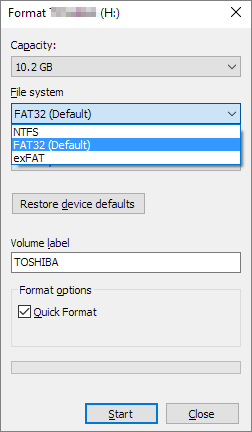
When the formatting finishes, close the formatting window. It's now NTFS and you can copy the backed up files back to the formatted device.
# 2. Format FAT32 to NTFS in Disk Management
Connect your external hard drive or USB drive to the PC before you start the formatting with the following steps:
Step 1. Right-click This PC or My Computer, select "Manage".
Step 2. Enter Device Manager and click "Disk Management"
Step 3. Open Disk Management and right-click the target device, select "Format".
Step 4. Set "NTFS" for the selected device, tick "Quick Format" and click "OK" to confirm.
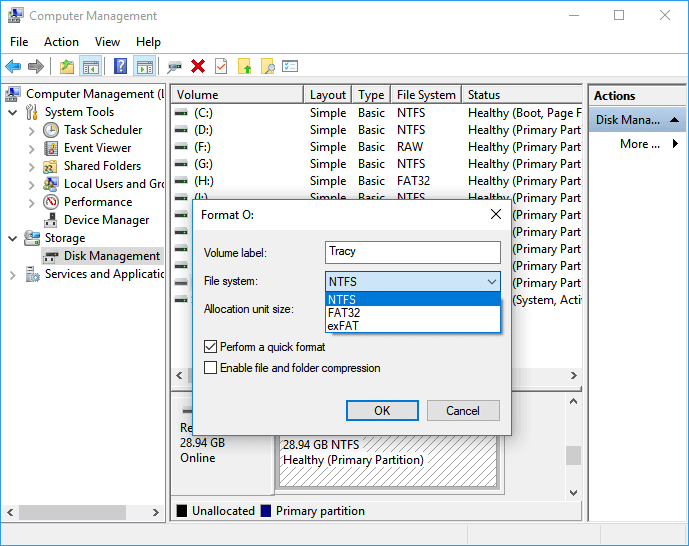
# 3. Quick Format FAT32 Device to NTFS in CMD
Step 1. Right-click on the Windows icon, select "Search" and type cmd.
Step 2. Right-click to run Command Prompt as administrator, type diskpart, and hit Enter.
Step 3. Type below command lines and hit Enter each time:
- list disk
- select disk 2 (Replace 2 with your USB disk number)
- list volume
- select volume 10 (Replace 10 with the volume number of the USB drive that you want to format)
- format fs=fat32 quick
Step 4. Type exit and hit Enter to close DiskPart when it reports to successfully format the volume.
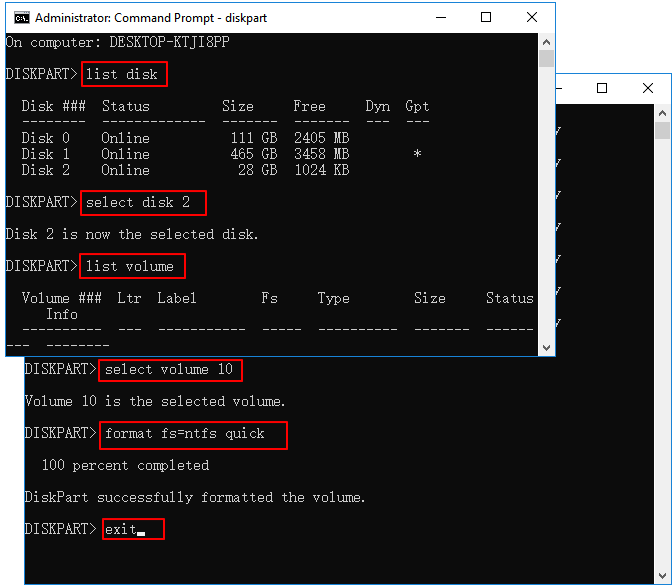
# 4. Format FAT32 to NTFS with Qiling Disk Master
Connect your external hard drive or USB drive to the PC before you start the formatting with the following steps:
Step 1. Launch Qiling Partition Master, click the partition you intend to format and click "Format".
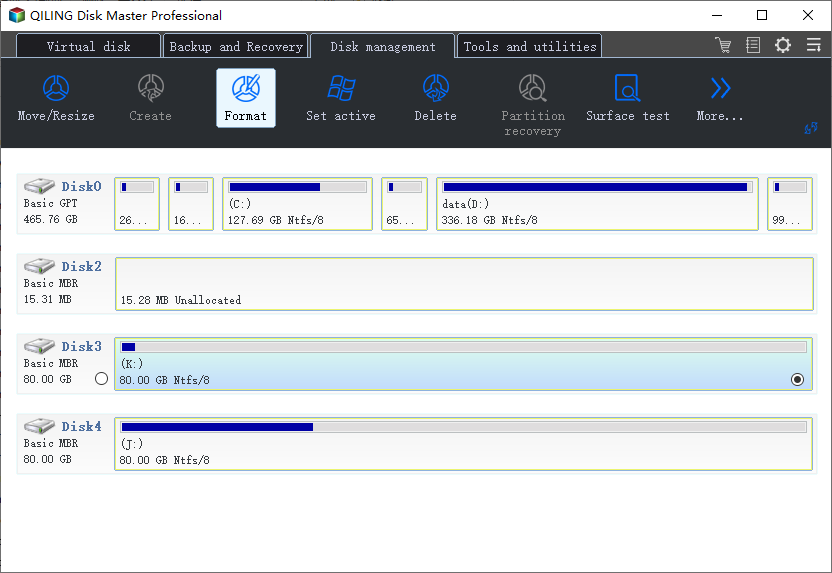
Step 2. In the next window, enter the Partition label, choose the NTFS file system, and set the cluster size according to your needs, then click "Proceed".
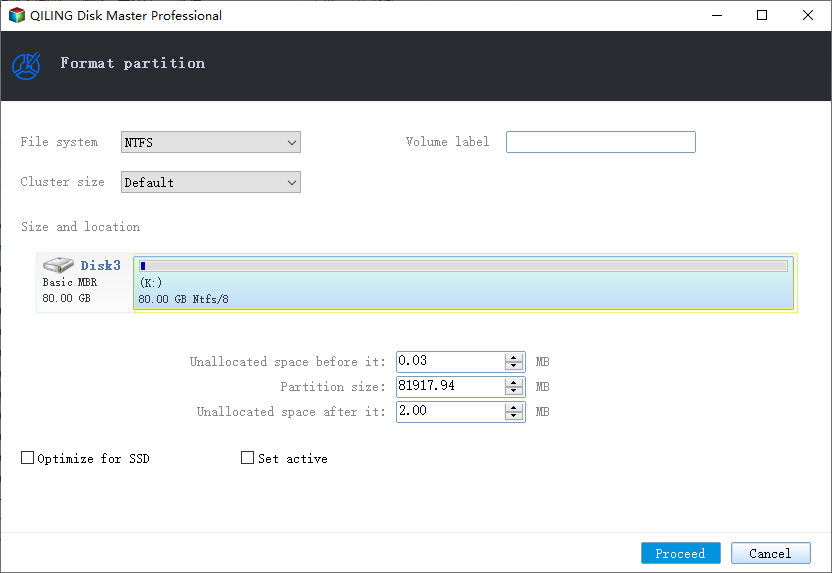
Warning: You'd better back up your necessary data because formatting will erase all data on the partition.
After finishing all the steps, you can copy files larger than 4GB successfully. Apart from converting file system, Qiling Partition Master also enables you to clone OS to SSD, resize partitions, and delete partitions as well.
The Bottom Line
Once you understand "the file is too large for the destination file system" is caused by the FAT32 file system, the solution is specific: change the file system. If you use the Windows built-in features or utilities to convert the file system, you need to back up the files on the storage device first since the operations will erase the files on your device. Thus, if you want to convert FAT32 to another file system directly without data loss, using Qiling Partition Master is more advisable for you.
Related Articles
- Format External Hard Drive with Multiple Partitions
- Format to FAT32 for USB or External Hard Drive in Windows 10
- Change File Extension One-by-One and in Bulk
- Format FAT32 Windows 11/10: How to Format HDD/External Hard Drive to FAT32
- CHKDSK Cannot Continue in Read-only Mode: Get 5 Fixes for CHKDSK Read Only Mode
- How to Ghost a Hard Drive in 3 Steps